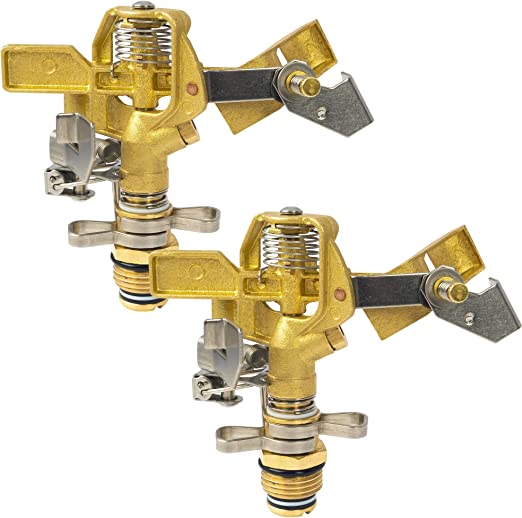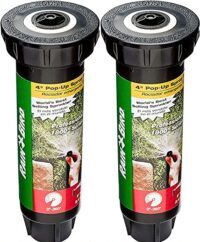Popular Sprinkler Heads Online
Sprinkler heads are an essential component of any irrigation system. These small, yet mighty devices are responsible for distributing water evenly across your lawn or garden, ensuring that your plants and grass receive the hydration they need to thrive.
There are several different types of sprinkler heads available on the market, each with its own unique features and benefits. Here are just a few examples:
- Rotary sprinkler heads: These heads rotate as they spray water, creating a circular pattern that covers a larger area. They are ideal for watering lawns and gardens with uneven terrain or slopes.
- Impact sprinkler heads: These heads use a hammer mechanism to produce a strong jet of water that can reach up to 100 feet. They are durable and long-lasting, making them a popular choice for large lawns or commercial irrigation systems.
- Spray heads: These sprinkler heads are designed to produce a gentle, mist-like spray that covers a smaller area. They are ideal for watering delicate plants or flowers, as the gentle spray reduces the risk of damage.
- Drip irrigation heads: These heads release water in a slow, controlled drip, making them a water-efficient choice for watering plants and gardens. They are particularly useful for watering plants with deep root systems or in areas with limited water resources.
It’s important to choose the right type of sprinkler head for your specific needs. Factors to consider include the size of the area you need to water, the type of plants you are watering, and the pressure and flow rate of your irrigation system.
In addition to choosing the right type of sprinkler head, it’s also important to properly maintain your sprinkler system to ensure it is functioning at its best. This includes regularly cleaning and adjusting the heads to prevent clogs or misalignments, as well as checking for leaks or broken parts.
Overall, sprinkler heads are a vital component of any irrigation system, and taking the time to choose the right type and properly maintain them can help ensure that your plants and grass receive the hydration they need to thrive.
Hourleey 1/2 Inch Brass Impact Sprinkler
The Hourleey 1/2 Inch Brass Impact Sprinkler Head is a game-changer when it comes to efficient and reliable garden irrigation. Crafted from high-quality brass, this sprinkler head is designed to deliver exceptional performance and withstand the test of time, making it an essential tool for any gardening enthusiast or professional landscaper.
Featuring an impact-driven mechanism, this sprinkler head provides a powerful and consistent water distribution. Its innovative design allows it to rotate in a full circle, covering a large area with ease. Whether you have a small lawn or a sprawling garden, the Hourleey Brass Impact Sprinkler Head ensures every inch receives the perfect amount of hydration.
With adjustable spray distance and angle, you have complete control over your irrigation system. Customize the reach and pattern of the water spray to match the unique layout of your garden. Whether you need to water delicate flower beds, lush lawns, or even agricultural fields, this sprinkler head has got you covered.
Durability is a hallmark of the Hourleey Brass Impact Sprinkler Head. The brass construction not only ensures resistance to rust and corrosion but also guarantees exceptional strength and longevity. This sprinkler head is built to withstand the elements, making it suitable for use in diverse weather conditions without compromising performance.
Installation is a breeze with the Hourleey Brass Impact Sprinkler Head. It easily connects to any 1/2 inch sprinkler riser or stand, allowing for quick and hassle-free setup. Once connected, simply adjust the spray pattern and distance to fit your watering needs, and let this sprinkler head take care of the rest.
Whether you’re a professional landscaper or a gardening enthusiast, the Hourleey 1/2 Inch Brass Impact Sprinkler Head is an invaluable addition to your irrigation system. Experience precision watering, incredible durability, and effortless installation with this top-of-the-line sprinkler head. Achieve lush greenery and thriving plants with the Hourleey Brass Impact Sprinkler Head – the perfect choice for superior garden irrigation.
Rain Bird 1804VAN
The Rain Bird 1804VAN Professional Pop-Up Sprinkler is the ultimate solution for achieving flawless irrigation in your lawn or garden. Engineered with precision and built to last, this sprinkler sets a new standard for professional-grade watering systems.
Equipped with a robust pop-up mechanism, the Rain Bird 1804VAN effortlessly rises from its housing, ready to deliver a precise and even spray pattern. With a spray radius of up to 15 feet, this sprinkler ensures optimal water coverage for your entire landscape, eliminating dry spots and promoting healthy plant growth.
What sets the Rain Bird 1804VAN apart is its innovative adjustable van nozzle technology. This unique feature allows you to fine-tune the spray distance and pattern, adapting to the specific needs of your lawn or garden. Whether you’re watering delicate flowers, dense shrubs, or expansive lawns, this sprinkler provides the versatility to customize your irrigation with unmatched accuracy.
Durability is a core principle of Rain Bird, and the 1804VAN is no exception. Constructed with rugged materials, including a stainless steel retraction spring and a UV-resistant plastic housing, this sprinkler is built to withstand the elements year after year. The reinforced design ensures reliable performance and longevity, even in the harshest conditions.
Installation is a breeze with the Rain Bird 1804VAN. The sprinkler head features a 4-inch pop-up height, making it easy to install and discreetly integrate into your landscape. Compatible with standard 1/2 inch NPT threaded risers, connecting the sprinkler to your existing irrigation system is seamless, allowing you to get up and running in no time.
Designed with water efficiency in mind, the Rain Bird 1804VAN is equipped with a water-saving feature that prevents runoff and overspray. By delivering water precisely where it’s needed, you can conserve water while ensuring your plants receive the perfect amount of hydration, resulting in healthier, more vibrant landscapes.
Whether you’re a professional landscaper or a dedicated homeowner, the Rain Bird 1804VAN Professional Pop-Up Sprinkler is the ultimate tool for achieving impeccable irrigation results. Experience the power of precision, durability, and water efficiency with this top-of-the-line sprinkler. Elevate your watering game with the Rain Bird 1804VAN and watch your landscape flourish like never before.


